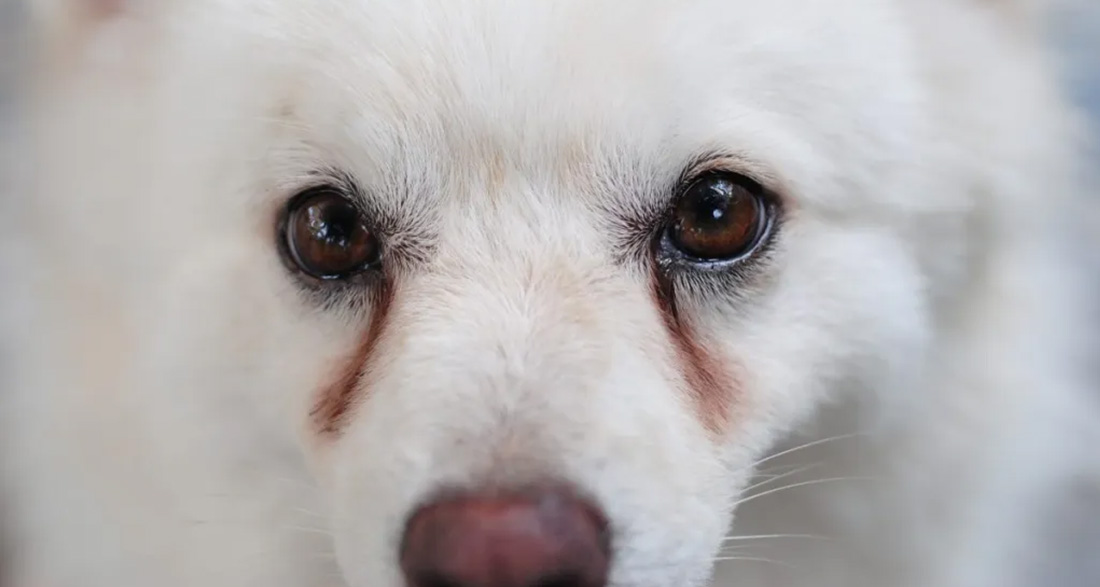Many dogs with white or very light fur develop reddish or reddish-brown discolorations around the eyes over time, in some cases also around the mouth, on the paws, or in the genital area – commonly known as tear stains.
- How Do Tear Stains Develop?
- Colorants in Tear Fluid
- Triggers and Factors for Excessive Tear Fluid
- Causes of Tear Stain Formation
- The Intestinal Flora as a Common Cause of Tear Stains
- Building Up the Intestinal Flora
- The Influence of Chicken on Tear Stains
- Chicken Farming Practices as a Cause
- Considerations for Dog Food to Avoid Tear Stains
- More Tips to Prevent Tear Stains
- Maltese – Particularly Prone to Tear Stains
This problem is particularly common in Maltese dogs. Some people attribute the cause of these fur discolorations to illness or inadequate care. However, this is only partially correct.
Instead, there are now plausible theories that consider factors such as stress and improper nutrition as the cause of tear stains. Feeding chicken frequently, in particular, seems to have a significant impact on the formation of tear stains.
How Do Tear Stains Develop?
In essence, it is entirely normal for a dog’s tear glands to produce a tear film. This film is necessary to keep the eyes permanently moist and to clean them regularly from dust, pollen, exhaust fumes, and other environmental factors. At the same time, the tear film in the animal’s eye provides special protection by preventing infections through regular cleaning.
The tear fluid contains many essential vitamins that the eye needs. Oxygen is also present in the tear fluid to optimally supply the eye externally. With each blink of the eyelid, the tear fluid is distributed in the eye. However, the tear fluid does not only moisturize the eyes but also the mucous membrane of the nose.
Colorants in Tear Fluid
Certain colorants, such as porphyrin, can be present in the tear fluid. This includes, among other things, a blood pigment that enters the body through the breakdown of cells. While this breakdown product is mainly excreted through feces, small amounts can also enter the saliva and the tears of the quadruped.
In this way, the discolorations, also known as tear stains, arise. It is not primarily a health problem; the tear stains are only perceived as visually disturbing.
Nevertheless, there is a cause for the excessive production of tear fluid or the pigments contained in it, which should be investigated more closely.

Triggers and Factors for Excessive Tear Fluid
Some dogs produce an excessive amount of tear fluid due to health or genetic factors, but the incorrect drainage of these fluids can also promote tear stains.
In a healthy quadruped, tear fluid is drained through the tear-nasal ducts. If these are too narrow, for example, due to a blockage of the ducts or an anatomical malformation of the tear-nasal ducts, the fluid flows instead over the eye and appears as a tear stain.
In the short term, this does not pose a problem, but in the long run, the salts contained in the tear fluid can irritate the skin, leading to persistent inflammations and even the formation of eczema.
Additionally, other factors contribute to increased tear production:
- Eye Inflammations
- Ingrown Eyelashes
- Eye Injuries
- Congenital Abnormalities and Narrowings in the Eye and Nose Area
Causes of Tear Stain Formation
Another cause that can favor tear stains is increased itching. Various factors can contribute to increased itching:
Especially, food allergies and harmful ingredients in the diet play an increasingly significant role. For producers, profit often takes precedence over genuine benefits for the dog.
The Intestinal Flora as a Common Cause of Tear Stains
The intestinal flora has a significant impact on the overall health of the dog. The intestine’s role is to extract nutrients from food and supply them to the body. A substantial part of the immune system is formed directly in the intestine.
If an imbalance occurs here, it can lead to many diseases – including tear stains. The cause is likely a change in the body’s own pH value, accompanied by acidification of the body.
To permanently reduce or completely avoid tear stains, the dog’s intestinal flora should be built up and strengthened.
Building Up the Intestinal Flora
Here are two products as examples; you can also use any other intestinal building supplements:
Zesty Paws and Purina Pro Plan Fortiflora.
Zesty Paws has been specially tailored to the needs of the dog’s intestine and serves the natural proliferation of healthy intestinal bacteria, which are insufficient in quantity during a strong intestinal load. This not only strengthens the dog’s intestinal flora but also the entire immune system.
Especially for tear stains, Purina Pro Plan Fortiflora is a good choice. It contains various herbs that regulate the body’s pH, making the tear fluid less acidic. Additionally, this agent contains some herbs with anti-inflammatory properties, thereby preventing the consequences of excessive tear production.
Important: According to the documents provided to us, these remedies help only in conjunction with a species-appropriate diet through high-quality wet food or BARF. Not with dry food – those still feeding dry food should possibly read the following article: Dry food is harmful.
Deworming treatments are said to negatively influence the building of a healthy intestinal flora. It’s best to start the intestinal building treatment after a deworming or refrain from deworming in the next 3 months unless there is an actual worm infestation.

The Influence of Chicken on Tear Stains
In recent years, some pet owners have identified feeding chicken as a cause of tear stains. A change in diet resulted in a significant reduction or complete disappearance of tear stains.
If chicken were generally the culprit for tear stains, many more dogs would be affected. It is therefore more plausible that it is not the consumption of chicken that triggers tear stains, but rather the quality of the food that plays a role.
Chicken Farming Practices as a Cause
Especially chickens are often kept in mass animal husbandry under disastrous conditions. To prevent diseases despite the associated unhygienic conditions, chickens receive numerous vaccinations, deworming treatments, antibiotics, and many other medications before slaughter.
Daily stress is inevitable in the overcrowded cages. The feed, mostly consisting of corn or soy, does not fully meet the nutritional needs of the chickens and primarily serves the purpose of fattening for maximum profit.
All these factors negatively impact the quality of the meat. During slaughter, all these pollutants remain in the chicken, so the subsequent dog food is also contaminated. These pollutants attack the dog’s intestinal flora and disrupt the balance.
Enriched with additional flavor enhancers, preservatives, dyes, and other artificial additives, the dog food has an even more harmful effect on the four-legged friend.
Consequently: When feeding a dog suffering from pronounced tear stains, it is advisable to opt for high-quality pet food, especially organic dog food or food-grade dog food.
Considerations for Dog Food to Avoid Tear Stains
To avoid tear stains in the long run, various factors play a role in pet food:
- Quality: Ensure to buy high-quality dog food in food-grade or organic quality so that the dog consumes as few pollutants as possible, allowing the intestinal flora to maintain its natural balance.
- Grain Content: The grain content in dog food should be as low as possible; ideally, the dog food should be gluten-free.
- Protein Sources: Ensure that the dog food contains a maximum of 1-2 different protein sources. Too many different protein sources can be processed and absorbed by the body only with additional effort.
- Meat Content: Dogs require a high meat content in their diet for complete and healthy nutrition, which should be at least 70-80%. Pay attention to the quality of the meat.
- Nutrients: A good complete dog food should cover the entire nutrient needs of the animal.
- Origin: In the EU, the regulations for animal husbandry are very high compared to international standards. However, dog food is often imported from non-European countries due to its low cost. When choosing pet food, pay attention to the origin of the ingredients.
In addition, you can supplement your dog’s daily diet with many aids that have a positive effect on the intestinal flora. This can significantly alleviate or completely eliminate tear stains.
For example, brewer’s yeast is a good option, as it has a very positive impact on the health of the intestine. Various algae that can be added to the food also serve as ideal support for the intestine. Even with treats, ensure that they meet high-quality standards.
More Tips to Prevent Tear Stains
While building a healthy intestinal flora is essential for sustainable tear stain treatment, you can achieve daily improvements with a few simple steps. We have an article on the topic: Foods for Building a Healthy Intestinal Flora.
Especially for long-haired dogs suffering from tear stains, it’s advisable to regularly trim the fur around the eye area to prevent the hair from hanging into the eyes.
On the contrary, it is counterproductive to tie the hair back with a hair tie or clip. This stresses the entire tissue around the eye area, making it easier for germs to enter the eyes and trigger eye inflammations.
Daily cleaning of the eye area is also beneficial if the dog produces increased tear fluid. A soft, non-linting cloth and lukewarm water are suitable for this purpose. This helps to quickly and effectively remove dust, hair, pollen, or other environmental substances.
When cleaning the eyes, ensure that you rub from the inside out to avoid transporting dirt particles further into the eye. If there are crusts, do not remove them roughly; instead, soften them gently with the cloth before carefully removing them.
Otherwise, injuries to the eyes may occur, which, in turn, can favor infections. Additionally, use a separate cloth for each eye to prevent transferring germs and contaminants from one side to the other.
Maltese – Particularly Prone to Tear Stains
Those who delve into the topic of tear stains will quickly notice that Maltese dogs are particularly affected by this condition. This is due to several reasons: Maltese eyes are relatively large compared to their bodies, making them particularly popular among dog owners due to their cute appearance.
However, this also exposes the eyes to considerable vulnerability, making them prone to contamination, inflammation, dust, and other environmental factors. Additionally, most Maltese dogs have long fur. The fine hairs often hang into the eyes, causing irritation and redness. Moreover, potential pathogens can more easily enter the eyes through the fur.
Both factors stimulate tear flow, but redness, dry eyes, or recurring conjunctivitis are possible consequences. Therefore, for breeds predisposed to tear stains, such as the Maltese, it is crucial to regularly check the eyes and investigate the causes of tear stains if they recur.
Conclusion – There is Relief for Tear Stains
The exact origin of tear stains is not definitively clarified, but it is well-established that a healthy intestinal flora and healthy eyes significantly reduce the risk of tear stains. With a nutritious diet, regular fur care, and daily eye cleaning, you can already alleviate tear stains considerably.


